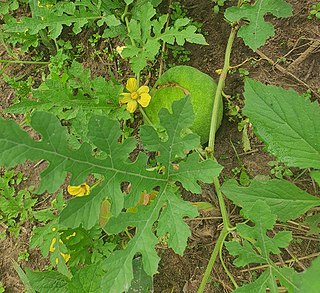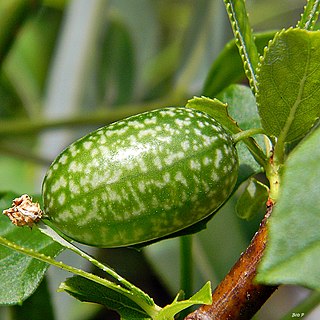
The Cucurbitaceae, also called cucurbits or the gourd family, are a plant family consisting of about 965 species in 101 genera. Those of most agricultural, commercial or nutritional value to humans include:

Melastomataceae is a family of dicotyledonous flowering plants found mostly in the tropics comprising c. 175 genera and c. 5115 known species. Melastomes are annual or perennial herbs, shrubs, or small trees.

Tibouchina is a neotropical flowering plant genus in the family Melastomataceae. Species of this genus are subshrubs, shrubs or small trees and typically have purple flowers. They are native to Mexico, the Caribbean, and South America where they are found as far south as northern Argentina. Members of this genus are known as glory bushes, glory trees or princess flowers. The name Tibouchina is adapted from a Guianan indigenous name for a member of this genus. A systematic study in 2013 showed that as then circumscribed the genus was paraphyletic, and in 2019 the genus was split into a more narrowly circumscribed Tibouchina, two re-established genera Pleroma and Chaetogastra, and a new genus, Andesanthus.

Cucumis is a genus of twining, tendril-bearing plants in the family Cucurbitaceae which includes the cucumber, true melons, the horned melon, and the West Indian gherkin.
William Botting Hemsley was an English botanist and 1909 Victoria Medal of Honour recipient. The standard author abbreviation Hemsl. is used to indicate this person as the author when citing a botanical name.

Sicyos is a flowering plant genus of the family Cucurbitaceae. Members of the genus may be known as "burr cucumbers", but the genus includes Sicyos edulis which is the christophine or chayote.

Sicana is a small genus of flowering plants in the family Cucurbitaceae. There are three or four species, found in rainforest and secondary scrub in the Caribbean and Central America.

George S. Vasey was an English-born American physician and botanist. He practiced medicine in Illinois for nearly two decades. He was appointed Chief Botanist at the United States Department of Agriculture in 1872, a position he held for the remainder of his life. His greatest achievement was the building up of the United States National Herbarium.

Melothria sphaerocarpa is a species of melon native from southern Mexico and the Dominican Republic through Central America to tropical South America. It has been introduced to western tropical Africa, where has been known under the synonym Cucumeropsis mannii, and is grown for food and as a source of oil, more often for the seed oil than for the fruit.

Apodanthera is a genus of plants in the family Cucurbitaceae. It includes 25 species native to the southwestern United States, Mexico, and South America from Ecuador and eastern Brazil to northern Argentina.

Cayaponia is among the largest genera in the gourd family, Cucurbitaceae, with 74 species. The plants are referred to as melonleaf. They are common from the southern United States to South America. Some species are also found in western Africa, Madagascar, and Fernando de Noronha, which is about 354 km (220 mi) off the coast of Brazil.

Melothria is a genus of flowering plants in the family Cucurbitaceae, native to the Americas from the United States to Argentina, and with some introductions in Africa and elsewhere. A number of Old World species formerly in Melothria were reassigned to Cucumis.

Chaetogastra is a genus of flowering plants belonging to the family Melastomataceae. Its native range is South America and North America. It contains around 115 species.

Ibervillea is a genus of flowering plants belonging to the family Cucurbitaceae.

Peponium is a genus of flowering plants belonging to the family Cucurbitaceae.
Microsechium is a genus of flowering plants belonging to the family Cucurbitaceae.
Jennie van Ackeren Dieterle was an American botanist, plant collector, curator, university teacher and taxonomist. She collected more than 3,700 plant specimens and identified over 570 of them, the majority from the Cucurbitaceae family. Most of the plants collected came from Mexico and the United States. She identified and named nine previously undescribed species of Cucurbitaceae. She has been recognised for her expertise in this family of plants and had an entire genus of Cucurbitaceae from Mexico named after her, known as Dieterlea.
Sicydium is a genus of flowering plants in the cucumber family, Cucurbitaceae. It includes nine species native to the tropical Americas, ranging from Mexico to northeastern Argentina.

Sechiopsis is a genus of flowering plants in the cucumber family, Cucurbitaceae. It includes five species native to Mexico and Guatemala.
















